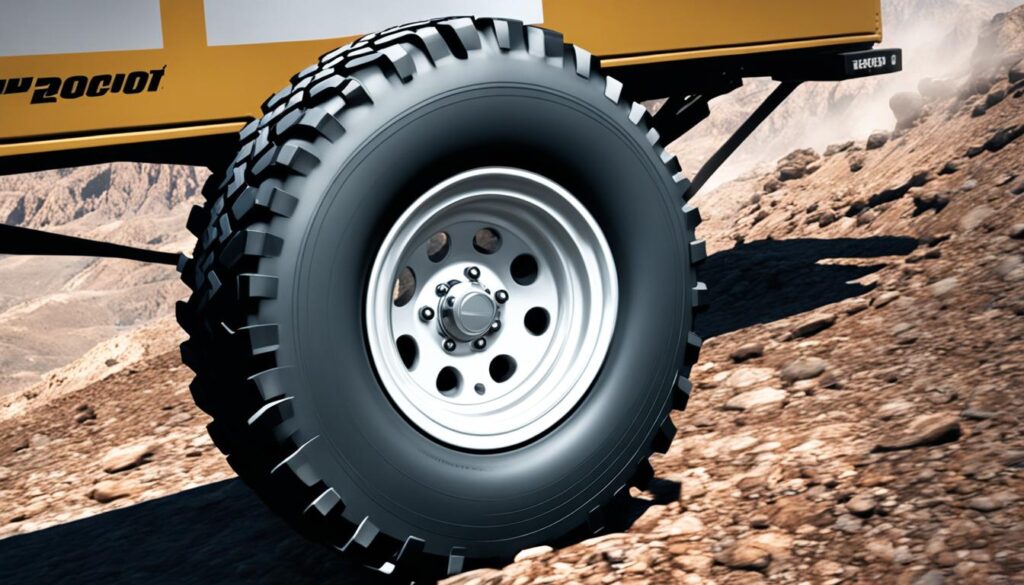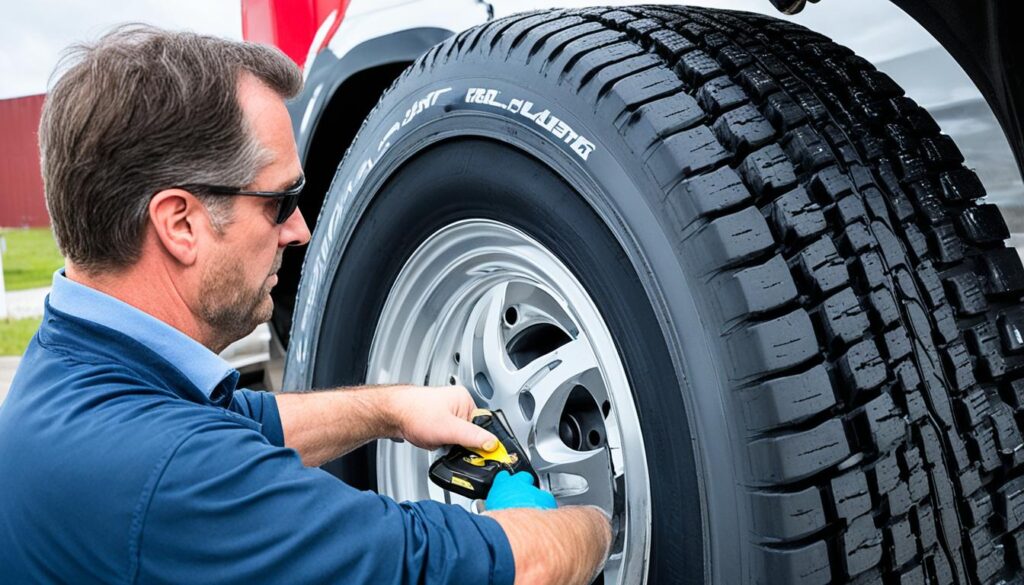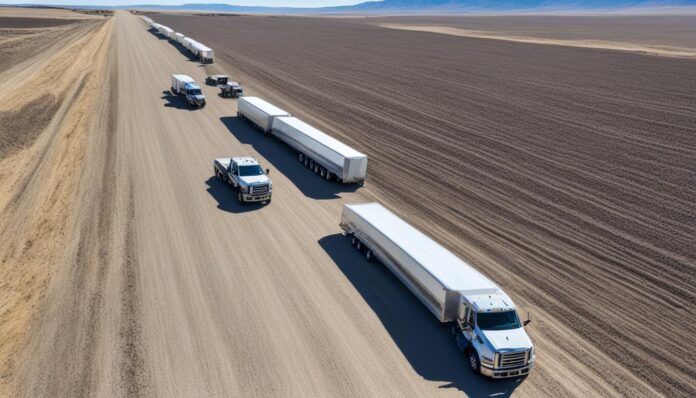As an Amazon Associate, I earn from qualifying purchases
When it comes to trailer tires, there are two main types to consider: bias ply and radial. Choosing the right type of tire can make a big difference in terms of performance and durability. In this article, we will compare bias ply and radial trailer tires, exploring their pros and cons to help you make an informed decision.
Key Takeaways:
- Bias ply tires offer better load-carrying capacity and sidewall puncture resistance.
- Radial tires provide better performance at higher speeds and on paved roads.
- Bias ply tires are commonly used in low-speed, off-road applications.
- Radial tires are preferred for paved road use due to their superior cornering ability and fuel economy.
- Factors to consider when choosing trailer tires include load rating, speed rating, construction, and size.
Bias Ply vs Radial: Construction and Differences
When it comes to trailer tires, understanding the construction and differences between bias ply and radial tires is crucial for making an informed decision. The tire construction directly impacts important factors such as load-carrying capacity, sidewall puncture resistance, and overall performance.
Bias ply tires are constructed with diagonal plies of rubberized nylon or polyester, giving them their distinct crosshatch pattern. These plies are layered at a specific angle to each other, providing excellent strength and resilience. The bias ply construction offers superior load-carrying capacity, making them well-suited for demanding off-road applications.
On the other hand, radial tires have overlapping plies of polyester, reinforced with steel mesh belts. This construction gives radial tires their characteristic radial configuration. Radial tires are specifically designed to dissipate heat more effectively, resulting in better durability and performance under higher speeds and on paved roads. Radials also excel in providing a smoother ride quality.
It’s important to note that bias ply tires have an inherent sidewall puncture resistance due to their sturdy construction. This makes them particularly reliable in rugged off-road terrains where hazards like sharp rocks or debris are common. Conversely, radial tires are less prone to sidewall punctures.
In summary, bias ply tires are known for their robust construction, offering excellent load-carrying capacity and sidewall puncture resistance. They are ideal for off-road applications. Radial tires, with their overlapping ply configuration, offer superior performance at higher speeds and on paved roads. Consider your specific needs and the intended use of your trailer to determine the most suitable tire type for optimal performance and safety.
Bias Ply vs Radial: Applications and Characteristics
When it comes to choosing between bias ply and radial tires, understanding their applications and characteristics is crucial. Each type has its own strengths and advantages depending on the intended use.
Off-Road Applications
Bias ply tires are widely used in low-speed, off-road applications such as agriculture, forklifts, and skid steers. These tires provide excellent traction and grip on uneven terrain, making them ideal for off-road environments. The robust construction of bias ply tires, with their sturdy sidewalls, ensures they can handle heavy loads without compromising performance.
On the other hand, radial tires are favored for paved road use due to their exceptional cornering ability and fuel economy. They are engineered to provide a smoother and quieter ride, making them suitable for highway driving and urban environments. Additionally, radial tires offer a higher load-carrying capacity, allowing for greater weight distribution.
Cornering and Fuel Economy
When it comes to cornering, radial tires excel due to their flexible sidewalls. This feature allows for better contact with the road surface, enhancing stability and handling around turns. The improved flexibility also contributes to better fuel economy by reducing rolling resistance, resulting in lower energy consumption and greater efficiency.
While bias ply tires may not offer the same cornering ability as their radial counterparts, they come with their own advantages. Bias ply tires possess stronger sidewalls, which provide increased resistance against punctures and impacts, making them highly suitable for off-road applications where rough terrain is prevalent.
Load-Carrying Capacity
Load-carrying capacity is another essential factor to consider when choosing between bias ply and radial tires. Bias ply tires have a reputation for their exceptional load-carrying ability, making them a popular choice for heavy-duty applications. With their sturdy construction and strong sidewalls, these tires can handle substantial loads without compromising performance.
While radial tires may not have the same load-carrying capacity as bias ply tires, they still offer substantial weight distribution capabilities. They are known for their ability to evenly distribute the load across the tire’s width, contributing to better stability and balance during transport.
| Tire Type | Applications | Characteristics |
|---|---|---|
| Bias Ply | Low-speed, off-road (agriculture, forklifts, skid steers) | Better traction and grip, strong sidewalls for heavy loads |
| Radial | Paved road, highway driving | Superior cornering ability, fuel economy, higher load-carrying capacity, smoother ride |
Overall, the choice between bias ply and radial tires depends on the specific requirements of your application. If you frequently navigate off-road environments and require excellent traction and sidewall strength, bias ply tires are the way to go. On the other hand, if you primarily drive on paved roads and prioritize cornering ability, fuel economy, and a smoother ride, radial tires are the better choice.

Choosing the Right Trailer Tires
When it comes to trailer tire selection, there are several important factors to consider. The load rating, speed rating, construction, and size of the tire all play a significant role in determining its suitability for your trailer’s needs. By understanding these key aspects, you can make an informed decision and ensure optimal performance and safety.
Load Rating:
The load rating of a trailer tire refers to the maximum weight it can safely carry. It is crucial to match the load rating of the tire to the weight of your trailer and its cargo. Failure to do so can result in tire failure or even accidents on the road. Always consult your trailer’s specifications or seek professional advice to determine the appropriate load rating.
Speed Rating:
The speed rating indicates the maximum speed at which the tire is designed to operate. It is essential to select a tire with a speed rating that matches or exceeds your intended driving speed. Driving at speeds exceeding the tire’s rating can lead to overheating, tire failure, or loss of control. Consider the nature of your trailer use and the speed limits you will encounter to ensure a suitable tire.
Construction:
The construction of the trailer tire is another crucial factor to consider. There are two main types: bias ply and radial. Bias ply tires have diagonal plies and are known for their robust load-carrying capacity and sidewall puncture resistance. Radial tires, on the other hand, have overlapping plies that provide better performance and durability at higher speeds and on paved roads. Choose the construction that best aligns with your trailer’s intended use and performance requirements.
Size:
The size of the tire should be compatible with your trailer’s specifications. It is essential to choose a tire that fits properly and provides adequate ground clearance. Consult your trailer manufacturer’s guidelines or seek professional assistance to determine the appropriate tire size.
By considering these factors – load rating, speed rating, construction, and size – you can select the right trailer tire for your specific needs. Remember to prioritize safety and performance when making your decision.
| Factor | Description |
|---|---|
| Load Rating | The maximum weight the tire can carry |
| Speed Rating | The maximum speed the tire is designed for |
| Construction | Options: Bias Ply or Radial |
| Size | The dimensions of the tire |
Remember to consult your trailer manufacturer’s guidelines or tire professionals for expert advice on trailer tire selection. Choosing the right tires will ensure your trailer performs optimally and safely, no matter the load or road conditions.
Trailer Tire Lifespan and Maintenance
Trailer tires are a crucial component of your trailer’s performance and safety. Understanding their lifespan and proper maintenance is essential for maximizing their longevity and ensuring reliable operation on the road. In this section, we will explore the average lifespan of trailer tires, as well as the key maintenance practices to keep them in excellent condition.
Trailer Tire Lifespan
On average, trailer tires have a lifespan of around three to five years. However, the actual lifespan can vary depending on several factors such as usage frequency, driving conditions, and proper maintenance. Trailers that are frequently exposed to harsh weather conditions, excessive sunlight, or extreme temperatures may experience accelerated tire wear and degradation.
Regular inspections of your trailer tires can help identify any signs of damage or excessive wear. It’s important to look out for cracks, bulges, or uneven tread wear on the sidewalls, as these can indicate potential tire failure risks. If you notice any issues, it’s best to have them addressed promptly by a professional.
Tire Maintenance Practices
Proper tire maintenance is key to extending the lifespan of your trailer tires and ensuring optimal performance on the road. Here are some essential maintenance practices to follow:
- Tire Rotation: Regular tire rotation is particularly crucial for bias ply tires to promote even wear. By rotating the tires, you can distribute the load and minimize the risk of premature tire replacement.
- Pressure Checks: Maintain the recommended tire pressure as specified by the manufacturer. Underinflated tires can lead to increased rolling resistance, heat buildup, and uneven wear, while overinflated tires may result in reduced traction and a harsher ride.
- Sidewall Inspection: Regularly inspect the sidewalls for any signs of damage, such as cuts, bulges, or punctures. Damaged sidewalls can compromise the tire’s structural integrity and increase the risk of blowouts.
- Cleanliness: Keep the tires clean from dirt, debris, and corrosive substances. Regularly washing the tires and removing any buildup can help prevent premature aging and damage.
By adhering to these maintenance practices, you can enhance the lifespan of your trailer tires and ensure safer and more reliable journeys.

Trailer Tire Lifespan and Maintenance Overview
| Lifespan | Maintenance Practices |
|---|---|
| Typically around 3-5 years |
|
Types of Trailer Tires: Bias Ply vs Radial
When it comes to trailer tires, choosing the right type is crucial for optimal performance and safety. Two main types of trailer tires dominate the market: bias ply and radial.
Bias ply tires are known for their excellent off-road traction and strong sidewalls, making them a popular choice for rugged terrain. They are constructed by layering multiple plies of rubberized nylon or polyester at diagonally opposing angles. This construction provides better load-carrying capacity and sidewall puncture resistance. However, bias ply tires tend to wear faster and offer less fuel efficiency than radial tires.
On the other hand, radial tires are designed to excel on paved roads. Their construction involves overlapping plies of polyester, strengthened with steel mesh belts. This design allows the plies to run radially from bead to bead, offering superior performance at higher speeds and a smoother ride. Radial tires also provide higher fuel efficiency compared to bias ply tires. However, they may come at a higher cost and have lower sidewall strength.
Advantages and Disadvantages of Bias Ply and Radial Tires
To help you make an informed decision, here’s a breakdown of the advantages and disadvantages of each type of trailer tire:
| Bias Ply Tires | Radial Tires | |
|---|---|---|
| Advantages |
|
|
| Disadvantages |
|
|
The choice between bias ply and radial tires ultimately depends on your specific needs and preferences. If you frequently venture off-road and require the extra traction and sidewall strength, bias ply tires may be the right choice for you. Conversely, if most of your towing takes place on paved roads and you prioritize fuel efficiency and a smooth ride, radial tires may be the better option.
Remember to consider factors such as the terrain you’ll be encountering, your towing frequency, and your budget when making your decision. By choosing the right type of trailer tire, you can ensure a safe and efficient towing experience.
Conclusion
In conclusion, when considering bias ply vs radial trailer tires, the best choice depends on the intended use and specific requirements. Bias ply tires are ideal for off-road applications and heavy loads, offering better traction and sidewall puncture resistance. On the other hand, radial tires excel on paved roads and at higher speeds, providing superior performance, fuel efficiency, and a smoother ride.
Both bias ply and radial tires have their pros and cons. Bias ply tires offer greater load-carrying capacity and stronger sidewalls, making them suitable for rugged terrain. However, they tend to wear faster and have lower fuel efficiency. Radial tires, while more expensive, provide better cornering ability, higher fuel economy, and a quieter ride. Yet, they may have lower sidewall strength.
When making a decision, it is essential to consider factors such as load carrying capacity, sidewall puncture resistance, cornering ability, and fuel economy. Evaluate the specific needs of your trailer and determine whether off-road performance or superior road handling and efficiency are a priority.
In summary, bias ply tires are the best choice for off-road applications and heavy loads, while radial tires are favored for paved roads and higher speeds. Carefully assess the pros and cons of each type, keeping your specific requirements in mind, to make an informed decision and maximize the performance of your trailer.
FAQ
What are the main differences between bias ply and radial trailer tires?
Bias ply tires are constructed with diagonal plies, offering better load-carrying capacity and sidewall puncture resistance. Radial tires, on the other hand, have overlapping plies, providing better performance at higher speeds and on paved roads.
What are the applications and characteristics of bias ply and radial trailer tires?
Bias ply tires are commonly used in low-speed, off-road applications, offering better traction, grip, and sidewall strength for heavy loads. Radial tires are preferred for paved road use, providing superior cornering ability, fuel economy, and a smoother ride.
How do I choose the right trailer tires for my needs?
When selecting trailer tires, consider factors such as load rating, speed rating, construction, and size. Match the load rating to the weight of your trailer and ensure the speed rating meets your desired driving speed. The construction (bias ply or radial) will impact performance, while the size should align with your trailer’s specifications.
What is the lifespan of trailer tires and how should I maintain them?
Trailer tires typically last around three to five years, depending on usage and driving conditions. Regularly inspect the sidewalls for signs of damage or wear. Practice proper tire maintenance, including regular rotation, to ensure even wear. It’s recommended to replace trailer tires after five years for optimal performance and safety.
What are the advantages and disadvantages of bias ply and radial trailer tires?
Bias ply tires offer better off-road traction, stronger sidewalls, and higher load-carrying capacity, but they wear faster and provide lower fuel efficiency. Radial tires excel on paved roads with superior cornering ability, fuel efficiency, and a smoother ride, but they may be more expensive and have lower sidewall strength.
What should I consider when choosing between bias ply and radial trailer tires?
The choice between bias ply and radial tires depends on your specific needs and preferences. Consider factors such as load carrying capacity, sidewall puncture resistance, cornering ability, and fuel economy when making a decision. Ultimately, the best choice will depend on the specific needs of your trailer.
